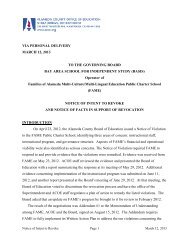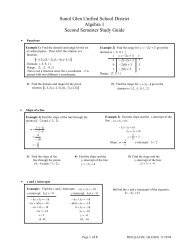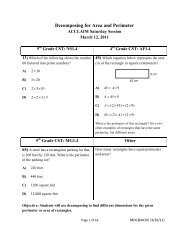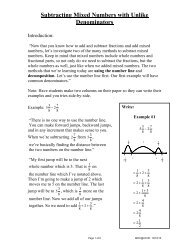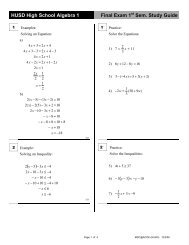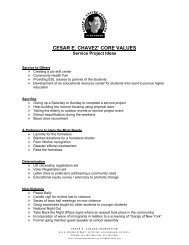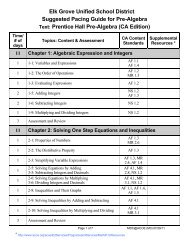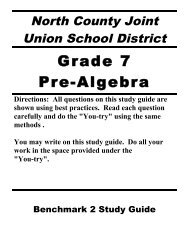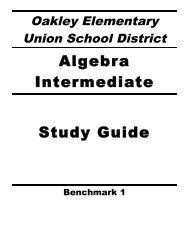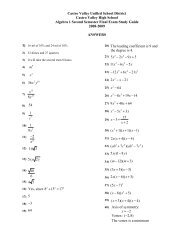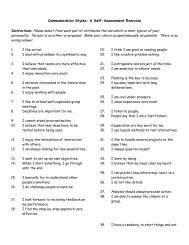Investigating Similar Triangles and Understanding Proportionality ...
Investigating Similar Triangles and Understanding Proportionality ...
Investigating Similar Triangles and Understanding Proportionality ...
- No tags were found...
You also want an ePaper? Increase the reach of your titles
YUMPU automatically turns print PDFs into web optimized ePapers that Google loves.
<strong>Investigating</strong> <strong>Similar</strong> <strong>Triangles</strong> <strong>and</strong> Underst<strong>and</strong>ing <strong>Proportionality</strong>: Lesson PlanPurpose of the lesson: This lesson is designed to help students to discover the properties of similar triangles. They willbe asked to determine the general conditions required to verify or prove that two triangles are similar <strong>and</strong> specificallyunderst<strong>and</strong> the concept of proportionality. This lesson is intended to be used as a way to introduce these concepts with theidea that formal postulates for proving triangle similarity will be supplied later.Warm-Up: This warm-up contains review problems regarding triangle congruence <strong>and</strong> parallel lines <strong>and</strong> transversals.Materials: Student h<strong>and</strong>outs with black line masters of triangles, tracing paper, rulers, warm-ups, investigations, studentpairings, <strong>and</strong> calculators (optional). Have an extra worksheet on h<strong>and</strong> that addresses similarity so that students who finishearly may practice more while others finish.Special Note: The black line masters may be used in different ways depending on the needs of your students <strong>and</strong> theresources you have for making copies. You may choose to photocopy a single triangle onto a sheet of colored paper <strong>and</strong>staple it to the back of the student h<strong>and</strong>out to display in class when finished with the activity. You may also choose tosimply photocopy it to the back of page five of the student h<strong>and</strong>out. That way, you could create student h<strong>and</strong>outs so thateach student in a pair has a different triangle to work with. Also, you may choose to photocopy the black line mastersonto card stock <strong>and</strong> re-use them in each class. Do as you see fit for your classroom.Directions: After the warm-up, refer to the lesson opener shown below. Be sure to awaken students’ prior knowledgethe best you can by referring to previous topics such as congruent triangles. After this discussion, place students in pairs<strong>and</strong> assign one partner to collect materials. Remind students how to measure using centimeters. Be sure to point out thatthe edge of the ruler may not indicate zero centimeters; they need to begin measuring the side length at zero centimeterswhich may be slightly inward from the edge of the ruler. Circulate <strong>and</strong> help students to verify side <strong>and</strong> angle measures.(This would be a great day to ask your coach to come in!) As students discover properties of similarity, help them togeneralize their thoughts <strong>and</strong> write sentences explaining their findings.Once all students have finished, debrief questions 10-13 as a class. This would be a good time to use some of yourfavorite debriefing strategies such as Think-Pair-Share, Think-Aloud, etc.After you have agreed upon the conditions required for triangle similarity, debrief the three practice problems, numbers14-16. It is a good idea to invite pairs of students to write their solutions on transparencies or on the whiteboard <strong>and</strong> havepairs share their findings with the class. Also, have two or three pairs display their work for question #16. They willlikely come up with many different answers <strong>and</strong> not all of them may be correct. If this happens, pose their questions tothe class <strong>and</strong> see if students can see how to adjust the triangles to satisfy the conditions for similarity.Closing: Ask students to write a summary of what they learned during the investigations. Use fill-in-the-blankstatements such as “Today I learned that triangles can be congruent <strong>and</strong> ______________.” (<strong>Similar</strong>) “In order for twotriangles to be considered similar, all three ________________ _____________(Corresponding angles) must be congruent<strong>and</strong> all three pairs of ______________ ______________ (Corresponding sides) must be _________________________.(Proportional) Feel free to vary these statements or write different statements. You may also consider having students’complete statements regarding two triangles. For example, give students three congruence statements about the angles oftwo triangles. Have them determine <strong>and</strong> fill in the missing corresponding angles. Do the same with the proportions of thesides. Have fun!Page 1 of 7MCN@ACOE 03/12/11
<strong>Investigating</strong> <strong>Similar</strong> <strong>Triangles</strong> <strong>and</strong> Underst<strong>and</strong>ing <strong>Proportionality</strong>: Lesson PlanNOTE: Depending on your book <strong>and</strong> your department, it may be best to discuss how you would like students to write<strong>and</strong> compare ratios of corresponding sides. In this investigation, we compare the larger triangle to the smaller triangle butyour book or colleagues may do it differently.Lesson Opener (Teacher Copy):Objective: This lesson is designed to help students to discover the properties of similar triangles <strong>and</strong> to specificallyunderst<strong>and</strong> the concept of proportionality. They will be asked to determine the general conditions required to verify orprove that two triangles are similar. This lesson is intended to be used as a way to introduce these concepts with the ideathat formal postulates for proving triangle similarity will be supplied later.• Ask the class: List all Triangle Congruence Postulates that you know. Draw a picture of congruent triangleswith the corresponding parts indicated for each postulate. (Quickly review each postulate.)SSS ASA SAS AAS HL (Right triangles)• Ask the class: Do you believe that having all three angles of a triangle congruent is another way to prove trianglecongruence? Is AAA a triangle congruence postulate? Why or why not?o Remind them that a general definition of congruence states that figures must be the same size <strong>and</strong> thesame shape in order to be considered congruent. Refer to the symbol for congruence ( ). Compare thisto the symbol for equality <strong>and</strong> discuss that this refers to the equality of values whereas congruence refersto figures having the same size <strong>and</strong> shape. Allow the students to discuss. Call on a few students to sharetheir thoughts. Encourage them to draw pictures to support their claims.• Explain to the students that the measures of the angles of a triangle do not dictate the lengths of the sides. Showseveral examples of pairs of triangles that have the same shape (where corresponding angles are congruent) butthat are not the same size. Try to reach a consensus that the triangles have the same shape but not the same size.• Ask the class: Can you think a word that you could use to describe these triangles that look very much alike butthat we have all agreed, are not congruent? (Hopefully, they will come up with the word similar!)oIntroduce the symbol for similarity (~) <strong>and</strong> compare it to the previous symbols for congruence <strong>and</strong>equality. Explain that this symbol, when written alone, can be used to denote that two figures have thesame shape but not necessarily the same size.• Ask the class: Do you think that, in the same way congruent triangles have interesting properties; similartriangles will have interesting properties? Today, we will find out what those properties are!Page 2 of 7MCN@ACOE 03/12/11
<strong>Investigating</strong> <strong>Similar</strong> <strong>Triangles</strong> <strong>and</strong> Underst<strong>and</strong>ing <strong>Proportionality</strong>: Lesson PlanTriangle #1Page 3 of 7MCN@ACOE 03/12/11
<strong>Investigating</strong> <strong>Similar</strong> <strong>Triangles</strong> <strong>and</strong> Underst<strong>and</strong>ing <strong>Proportionality</strong>: Lesson PlanTriangle #2Page 4 of 7MCN@ACOE 03/12/11
<strong>Investigating</strong> <strong>Similar</strong> <strong>Triangles</strong> <strong>and</strong> Underst<strong>and</strong>ing <strong>Proportionality</strong>: Lesson PlanTriangle #3Page 5 of 7MCN@ACOE 03/12/11
<strong>Investigating</strong> <strong>Similar</strong> <strong>Triangles</strong> <strong>and</strong> Underst<strong>and</strong>ing <strong>Proportionality</strong>: Lesson PlanTriangle #4Page 6 of 7MCN@ACOE 03/12/11
<strong>Investigating</strong> <strong>Similar</strong> <strong>Triangles</strong> <strong>and</strong> Underst<strong>and</strong>ing <strong>Proportionality</strong>: Lesson PlanTriangle #5Page 7 of 7MCN@ACOE 03/12/11
Warm-UpCST/CAHSEEIn the diagram below, .Which of the following conclusions doesnot have to be true?A. <strong>and</strong> are supplementary angles.B. Line l is parallel to line m.C.D.What do we call the pairs of angles in answer choices C <strong>and</strong> D?Use the proof to answer the questions below.Given: ; D is the midpoint of .Prove:ReviewStatementReason1. ; D is the midpoint of . 1. Given A. AAS2. 2. Definition of Midpoint B. ASA3. 3. Reflexive Property C. SAS4. 4. ? D. SSSToday’s St<strong>and</strong>ards:CA State St<strong>and</strong>ard Geometry 4.0: Students prove basic theorems involving congruence <strong>and</strong> similarity.CA State St<strong>and</strong>ard Geometry 5.0: Students prove that triangles are congruent or similar, <strong>and</strong> they are able to use theconcept of corresponding parts of congruent triangles.
Warm-UpCST/CAHSEEIn the diagram below, .Which of the following conclusions doesnot have to be true?A. <strong>and</strong> are supplementary angles.B. Line l is parallel to line m.C.D.What do we call the pairs of angles in answer choices C <strong>and</strong> D?Corresponding Angles <strong>and</strong> Alternate Interior AnglesUse the proof to answer the questions below.Given: ; D is the midpoint of .Prove:ReviewStatementReason1. ; D is the midpoint of . 1. Given A. AAS2. 2. Definition of Midpoint B. ASA3. 3. Reflexive Property C. SAS4. 4. ? D. SSSToday’s St<strong>and</strong>ards:CA State St<strong>and</strong>ard Geometry 4.0: Students prove basic theorems involving congruence <strong>and</strong> similarity.CA State St<strong>and</strong>ard Geometry 5.0: Students prove that triangles are congruent or similar, <strong>and</strong> they are able to use theconcept of corresponding parts of congruent triangles.
<strong>Investigating</strong> <strong>Similar</strong> <strong>Triangles</strong> <strong>and</strong> Underst<strong>and</strong>ing <strong>Proportionality</strong>Objective: This lesson is designed to help you discover the properties of similar triangles <strong>and</strong> to specificallyunderst<strong>and</strong> the concept of proportionality. You will be determining the general conditions required to verify orprove that two triangles are similar.1. List all Triangle Congruence Postulates that you know. There are five!Draw a picture of congruent triangles with the corresponding parts indicated for each postulate.(Right triangles)2. Do you believe that having all three angles of a triangle congruent is another way to prove trianglecongruence? Is AAA a triangle congruence postulate? Why or why not?Symbol for Congruence: ________________Symbol for Equality: ________________3. Draw several examples of pairs of triangles that have the same shape (corresponding angles arecongruent) but that are not the same size.4. Can you think a word that you could use to describe these triangles that look very much alike but that wehave all agreed, are not congruent? _______________________________________________________Symbol for _________________: ________________Page 1 of 5MCN@ACOE 03/12/11
<strong>Investigating</strong> <strong>Similar</strong> <strong>Triangles</strong> <strong>and</strong> Underst<strong>and</strong>ing <strong>Proportionality</strong>Directions:Identify the two triangles in your picture, (the larger triangle) <strong>and</strong> (the smaller triangle).You will be asked to identify <strong>and</strong> record certain measurements from each triangle in the chart below.1. Using your ruler, measure the lengths of the sides of your larger triangle, in centimeters. Youwill be measuring sides <strong>and</strong> . Round to the nearest tenth of a centimeter.Record the measurements below.2. Using your ruler, measure the lengths of the sides of the smaller triangle <strong>and</strong> incentimeters. Round to the nearest tenth of a centimeter. Record the measurements below.3. Record the angle measures of your larger triangle, . You will be recording <strong>and</strong> .Verify that the sum of the angles is .4. Using your ruler, connect the two points D <strong>and</strong> E to create , a segment parallel to segment .Try to be careful <strong>and</strong> precise!5. Using what you know about parallel lines <strong>and</strong> transversals, find the measures of <strong>and</strong> .Record the information below. What reasons could you give for why these angles have thesemeasures?________________________________________________________________________________________________________________________________________________________________________6. What is the measure of ? Why?____________________________________________________________________________________*Steps 1-6: Record measurements here.*Measurements forMeasurements forPage 2 of 5MCN@ACOE 03/12/11
<strong>Investigating</strong> <strong>Similar</strong> <strong>Triangles</strong> <strong>and</strong> Underst<strong>and</strong>ing <strong>Proportionality</strong>7. Using your ruler, your pencil <strong>and</strong> a piece of tracing paper, trace the smaller triangle, . Glue ortape it to your paper next to . You now have two similar triangles.8. In the table below, identify <strong>and</strong> list the corresponding sides <strong>and</strong> the corresponding angles of yourtwo triangles. Also, label each of the side lengths <strong>and</strong> angle measures on the two pictures.(Label on the paper <strong>and</strong> label on the tracing paper.)Corresponding SidesCorresponding Angles9. Create ratios using the corresponding sides of the two triangles. Refer to your chart above for help.Write the ratios as shown in the table below. Once you have set up the ratios, find the quotient.(Use your calculator to find the answer to the division problem!)Ratio #1 Ratio #2 Ratio #310. What do you notice about the ratios of the corresponding sides?__________________________________________________________________________________________*We say that the sides are proportional because the ratios of the corresponding sides are ________________.Page 3 of 5MCN@ACOE 03/12/11
<strong>Investigating</strong> <strong>Similar</strong> <strong>Triangles</strong> <strong>and</strong> Underst<strong>and</strong>ing <strong>Proportionality</strong>11. What did you notice about the measures of corresponding angles?12. What have you discovered about similar triangles?13. In your opinion, what conditions must be met in order for triangles to be considered similar?Do you think that these same conditions could apply to any closed figure? (Hexagon? Pentagon?)Applying what you have learned:14. The two triangles below are similar. Explain why.(Hint: Check all measures of corresponding angles <strong>and</strong> compare ratios of corresponding sides.)Page 4 of 5MCN@ACOE 03/12/11
<strong>Investigating</strong> <strong>Similar</strong> <strong>Triangles</strong> <strong>and</strong> Underst<strong>and</strong>ing <strong>Proportionality</strong>15. For what values of x <strong>and</strong> y are the two triangles similar?(Hint: The sides must be proportional; you will have to write a proportion.)16. Here are two triangles that appear to be similar. Assign angle measures <strong>and</strong> side lengths that will makeyour two triangles similar. Have your partner verify that you created similar triangles.Page 5 of 5MCN@ACOE 03/12/11



